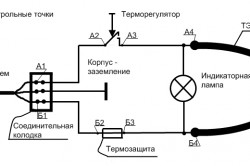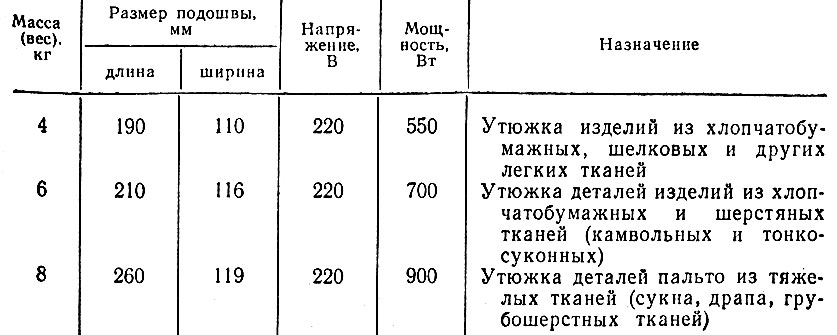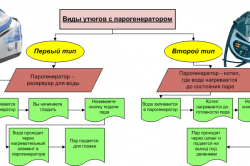Sections of the site
Editor's Choice:
- How to unlock ariston washing machine
- Pros and cons of LED lighting
- Pulse relay: device and connection
- How to calculate the illumination of a room with LED lamps?
- Plastic box - do-it-yourself aesthetic view of electrical wiring
- Electricity consumption of a warm floor: electric and film
- Installing a pump in a well: how to properly install pumping equipment
- Electrician Toolkit Overview
- How to choose a water heater: the most complete list of evaluation criteria
- 1 acoustics on the example of Sven SPS-860 and Realtek ALC889 codec
Advertising
| General information on electric irons |
|
Add site to bookmarks General information on electric ironsThe very sound of the words "electric iron" is bewildering - after all, there are no non-electric irons. Until relatively recently, coal iron was widely used. It looked like a small iron box with heated coals poured into the core. This box with a handle was swung vigorously in different directions so that the coals warmed up and began to create heat for ironing. You can’t work with such an iron for a long time, as coals tend to cool down. A revolutionary revolution in history occurred when the iron body of the iron was connected to an electric heating coil. From that time immemorial, the iron has become an electrical household appliance. Laundry and ironing are labor-intensive processes in the household. Various types of electric irons are used for ironing clothes. At the moment, several types of irons are offered in the market in a wide range at once. They differ in the type of processing that is required for a particular fabric. Three types of irons are produced: without heating temperature control, with a thermostat, with a thermostat and a humidifier. Also, electric irons are produced in accordance with GOST 307-69. They are designed to operate on 127V or 220V single phase AC. To generate heat in electric irons, and in many heating devices, a high-resistance wire (usually nichrome) is used. The wire is often wound in a spiral pattern. Sometimes flat elements made of nichrome wire wound on a plate of insulating material (ceramics, multilayer mica plates, etc.) are used as heating elements. To create a higher temperature, the heating elements are made in the form of rods, since they can be placed closer to the heating surface. Such a heating element is placed in the center of a hollow metal tube, between it and the walls of the tube there is a sheath of insulating material. The edges of the tube are sealed, so the action of moisture and air does not cause damage to the elements. After the tube is sealed, it is given the desired shape. When an electric current passes through a conductor, heat is released - it heats up. With an increase in the magnitude of the current, the heating of the conductor increases in a quadratic dependence. If the current doubles, the heating of the conductor increases four times.
The advantages of an electric heating iron over others previously used are well known. These are, first of all, small dimensions, lightness, absence of harmful impurities during combustion, cleanliness of the workplace. The sole of the device is made of aluminum, but can also be made of cast iron. The sole is equipped with a heating element, and then, together with a thermostat, is fixed on the body. The operability of the tubular electric heater is controlled by a signal light. If the electric heater has warmed up to the temperature that the consumer needs and is ready for operation, then the light simply goes out. The nichrome coil and the heating element operate in parallel, and the signal light consumes 3.5 V from a voltage drop in a relatively small section of the spiral. In order for the heating element to cool down, the circuit is broken, consisting of a plate heated from the sole of the device (made of two metals), it bends and begins to squeeze out the contact plate due to the difference in thermal expansion coefficients. But in order for the heater to work again, the following happens: the bimetallic plate bends when it cools, thereby freeing the contact plate. The characteristics of this or that iron can be instantly determined if you can carefully read and understand the label, passport or in the appendix to the electrical appliance. Surely every buyer at least once in his life, faced such a problem as a misunderstanding of what is written in the device passport. I would like to update the iron, but do not know which model to choose. You look into the application, and there are incomprehensible letters, numbers and words. What do they stand for? Everything is very simple! Conventions or abbreviations:
Now, when everything is more or less clear with the letters, it is the turn of the numbers that follow them. They also denote the power and mass of the iron. For example, the application has the designation UTP 1000-2.0. This designation is translated as follows - an iron with a thermostat equipped with a steam humidifier, the power consumption is 1 kW, and the mass of the device is 2 kg. From what is the mass of the device, you can find out the warm-up time. For example, weighted irons are considered the most difficult to heat up. It takes about 8 minutes to warm them up. If the mains voltage is nominal, the lower working part (sole) of the iron without a thermostat heats up to a temperature of 200 in 12-15 minutes. Such irons have a number of disadvantages compared to irons with a thermostat (large mass, slow heating, higher power consumption). The heating time of irons with a thermostat is 2.5-3 minutes. They are convenient, light and economical, more productive and safe in terms of fire. The required temperature is set on the scale with the thermostat lever. The temperature control of the iron automatically maintains a constant temperature on the soleplate, which is necessary for ironing certain types of fabrics. Temperature regulators are usually bimetallic elements placed inside the heating device. The bimetal element plays the role of a circuit breaker connected in series with the heating element. When the heating element becomes hot, it releases heat which heats the bimetal element. The bimetallic strip opens the contact and breaks the circuit. When the heating element is cooled, its temperature decreases, the bimetallic strip narrows and straightens. The electrical circuit closes - the heating element releases heat again. In addition to irons with a thermostat, irons with a thermostat and a steam humidifier are also available. The presence of a steam humidifier expands the possibilities of using the iron, allows you to iron fabrics without pre-moistening. Drip type humidifiers are used in such irons. For the water necessary for steam generation in the iron, there is a tank with a capacity of 100 to 150 cm³, which is also a valve. There is a steam chamber in the soleplate of the iron. When the steam regulator is set to the “Steam” position, the water poured into the tank enters the evaporation chamber in drops, evaporating, leaves the holes of the sole, saturating the ironed material with steam. The start time of vaporization does not exceed 4 min. The water supply ensures the evaporation mode for at least 20 minutes. The evaporation rate is at least 5 g/min. The amount of current leakage in irons is not more than 0.5 mA when the thermostat knob is set to the upper heating stage. The roughness of the sole of the iron is not lower than 8 cells. purity. The soleplate of irons made of cast iron is usually chrome-plated. The length of the connecting cord of the iron is 2 m. The body of this model does not slip when ironing with the entire sole, it comes into contact with the fabric at several points, thereby reducing the heating of the body from the sole. The following heating elements are used in irons: wire spiral with porcelain beads put on them; tubular built-in or poured into the sole of the iron; lamellar in the form of nichrome or fechral wire (or tape) wound on mica or micanite. When you turn on a cold iron, the signal lamp lights up - the circuit of the heating element is closed. When the lamp goes out, your appliance is ready for use. Further switching on and off of the signal lamp characterizes the normal operation of the iron.
For the performance of an iron, the main thing is how much heat it produces and whether this heat can be controlled. Thermostat irons have this advantage. They are convenient, light and economical, more productive and safer in terms of fire than irons without thermostats. These irons reduce the warm-up time from 15-20 minutes to 3-8 minutes. Increased energy savings by 10-15%, and labor productivity increased by 40-60%. The advantages also lie in the fact that these irons prevent the possibility of singeing and melting of fabrics, which is especially important now, when a large number of synthetic fibers are produced, for ironing which it is necessary to strictly observe the temperature regime. The temperature regulator of the device will maintain the temperature you need automatically throughout the ironing of the linen. Irons with a thermostat have a scale of names: nylon, silk, wool, cotton, linen. The maximum temperature (°C) in the center of the soleplate of irons when the regulator knob is set on the fabric name scale is within:
Technical data for some types of irons.
Irons without thermostats consume power ranging from 320 watts to 400 watts. Rated voltage - from 127 V to 220 V. Heating element type - spiral. Weight in kilograms from 2.1 to 3.0. Irons with thermostats. Consume power from 200 to 1000 watts. Rated voltage from 127 to 220 V. Type of heating element - tubular and spiral. Weight in kilograms - from 0.65 to 2.55. Irons with thermostat and humidifier. Power consumption - 750-1000 watts. Rated voltage - 127-220 V. Type of heating element - tubular. The capacity of the water tank is 100-200 cm³. Weight - 1.5-2.0 kg. Irons without thermostats have some disadvantages: the iron heats up much more slowly. More electricity consumption. Due to the low power, the iron cools down quickly when ironing.
Symbols of irons indicating the permissible ironing temperature.
|
New
- I am a big tea lover. I especially respect green
- Ivan-tea with the addition of mint The chemical composition of the plant
- What is useful wheat porridge for the body
- Recipe: Soy Schnitzel - An excellent and tasty substitute for meat during Lent
- How to make ginger tea
- Coconut manna: benefits and harms, recipes with organic product Coconut paste how to use
- "Healthy" vegetable oils - a possible cause of obesity
- Adnexitis: causes, symptoms and treatment of the disease
- Herpes during pregnancy. Types, symptoms, treatment. Treatment of herpes during pregnancy Ointment for herpes during pregnancy
- What is pink catharanthus and how to care for it?









